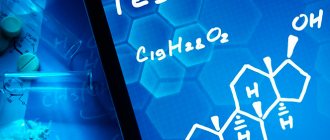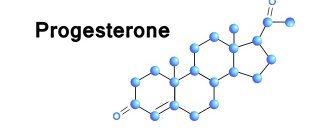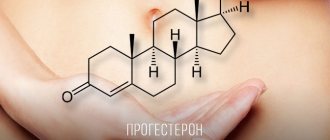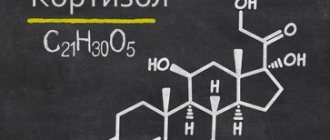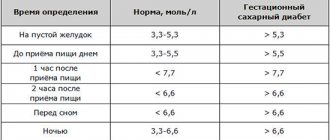The level of testosterone in women varies depending on many factors: age, time of day, phase of the menstrual cycle, etc. Deviation upward or downward may indicate pathology, but can also be associated with a sedentary lifestyle, psycho-emotional overload, poor nutrition, chronic stress . To identify the cause of the disorder and correct it, you should consult a doctor.
Testosterone (from the Latin testis - male testicle, male strength and stereos - hard) is a male sex hormone that ensures normal sexual development in men and women, regulates puberty and sexual function, and influences the development of secondary sexual characteristics. Its biosynthesis occurs with the participation of gonadotropic hormones of the pituitary gland - follicle-stimulating and luteinizing.
Testosterone in women is produced by the adrenal glands and ovaries.
The precursor to testosterone is cholesterol, which enters the hormone-synthesizing cells of the glands as part of lipoproteins. Testosterone biosynthesis begins with the cleavage of the cholesterol side chain and occurs through a series of sequential enzymatic reactions in which tissue enzymes participate. During biosynthesis, testosterone completely loses its side chain and is transported into the bloodstream.
Excess testosterone is caused by poor diet, obesity, and taking certain hormonal medications.
Circulating in the bloodstream, the main part (40–60% of total testosterone) combines with sex hormone-binding globulin, turning into a metabolically inactive form. The remainder of circulating testosterone is weakly bound to albumin, and only about 1–2% of total testosterone remains in free form. Free testosterone and testosterone bound to albumin are available to tissues and easily penetrate target cells. During the process of metabolic activation, testosterone is converted into a more active form - dihydrotestosterone, a small part is transformed into estradiol. Testosterone inactivation occurs in the liver.
Hormone functions
In the body itself, this hormone performs the following important functions:
- It is directly involved in the natural production of elements and the formation and construction of bone tissue and thereby contributes to the direct growth and strengthening of bones and skeleton in the body.
- Under its influence, the muscular skeleton is formed, and the figure will develop according to its feminine , but not masculine type - the breasts grow and the thighs increase in volume. If there is a deviation from the norm, in particular in the direction of increase, in this case a figure is formed exclusively according to the male type, when increased hair growth develops on the face and body, shoulders increase in size, and so on.
- It takes an active part in the formation of brain cells and the central nervous system - it is he who is responsible for such important functions as memory and thinking, and forms a woman’s special character traits.
- that a special hormone, estrogen - estradiol, is formed during the work of the female endocrine system
- Among other things, this hormone in a woman’s body also affects the sufficient production of all sex hormones by the pituitary gland , which in turn regulate the normal functioning of the ovaries and the development and subsequent release of the follicle into them.
Testosterone in women
Testosterone has a major impact on women's sexual and reproductive health. The main sources of male hormone in women are the adrenal cortex and ovarian cells. Small amounts are secreted in the placenta, muscle, skin and adipose tissue.
What is the hormone testosterone responsible for in women?
- affects protein, carbohydrate, fat metabolism, takes part in the synthesis of lipoproteins in the liver, improves the body's absorption of minerals and water, controls blood sugar levels;
- regulates the development of the bone skeleton and bone growth during puberty, is responsible for bone density;
- increases protein synthesis and breakdown, is responsible for the growth of muscle mass;
- regulates the functions of the reproductive system;
- affects the maturation of the egg and the formation of the corpus luteum;
- participates in maintaining normal physiology in pregnant women;
- influences the formation of mammary glands;
- responsible for the development of adipose tissue;
- regulates the process of natural sweating;
- activates the work of the sebaceous glands;
- responsible for sexual hair growth, affects hair follicles;
- reduces the risk of cardiovascular diseases;
- causes changes in brain activity, has a stimulating effect on the development and functioning of the nervous system, increases stress resistance and endurance;
- stimulates sexual desire.
A decrease in testosterone production in women can be caused by pathologies of the pituitary gland, hypothalamus, adrenal glands, ovarian tumors, endocrine and autoimmune diseases, and surgical menopause.
Deviation of testosterone levels from the norm in women significantly affects their health and appearance.
Carrying out analyzes
To determine the level of testosterone in the patient’s body, doctors take blood from a vein and conduct a study.
Donate blood on days 6-9 of the menstrual cycle, when the level of this hormone is most stable. If a woman’s menstruation is irregular, then only the doctor determines the date of blood donation.
How to prepare?
- To obtain accurate and reliable results, it is important to prepare in advance for the analysis. It is important to eliminate alcohol and not smoke 12-15 hours before, and stop taking hormonal drugs and medications at least 24 hours before.
- It is also important to give up sexual relations and excessive physical activity a day before, and temporarily remove fatty and spicy foods and spices from your diet.
When is it held?
The analysis for the level of determination of the hormone is mandatory only in the morning, on an empty stomach - you are allowed to drink only water.
For subsequent laboratory testing, venous blood is taken from a woman’s vein - such manipulations are carried out in the laboratory using a disposable syringe.
The procedure itself is quick and does not cause any discomfort.
Where to submit?
You can donate blood from a vein either in a public or private clinic that has an equipped laboratory and permission to conduct this type of analysis and research.
Cost of analysis
Regarding the question of the cost of analysis in a private clinic, the price varies from 470 to 940 rubles when carried out in a private clinic; in a public medical institution it will be less.
This figure may change - in this case, not only a state or private laboratory is taken into account, but also the urgency of the research and the volume of consumables are taken into account.
Several ways to increase male hormones on your own
The diet is adjusted as follows.
- The daily menu increases the amount of meat products - meat, fish, poultry; you need to cook vegetables for a side dish, and fruit for dessert.
- It is advisable to exclude baked goods and pasta.
- Coffee, alcohol and smoking block the production of testosterone - as well as the overall functionality of the hormonal system. Bad habits must be abandoned.
- You should not allow yourself to become overtired - you need to sleep at least 8 hours a day.
- You definitely need to breathe fresh air, lead an active lifestyle, and play sports.
- Doctors do not advise women to drink protein shakes unless they are involved in strength sports.
This dietary supplement greatly affects the level of the hormone, and its excess is extremely harmful for women. If you need a protein shake, it is better to make it yourself without including chemical additives in the recipe.
Protein shakes at home:
- Grind 80 g of fresh medium-fat cottage cheese until pureed, pour a glass of milk, mix with a spoonful of honey, banana puree and 2 tablespoons of oatmeal. Blend until smooth in a blender;
- Cottage cheese in an amount of 200 g is mixed with any juice with pulp - to your taste. Add ripe persimmons and half a glass of kefir to the curd and juice puree. Beat everything in a blender. If desired, persimmons can be replaced with banana;
- This cocktail not only increases testosterone, but also improves your mood. It is necessary to make a milkshake from milk - 500 ml, cream 15% fat - 100 ml, and a portion of ice cream. For taste, add half a teaspoon of cinnamon and vanilla to taste. Separately, beat 1 large or two ripe bananas with a tablespoon of fresh honey and also beat into the drink.
Homemade protein shakes are as effective as protein supplements.
Additional tests
If the data obtained from laboratory testing is insufficient to clarify preliminary diagnoses, doctors may prescribe additional tests.
So additional analyzes in this case may include:
- determination of the level of adrenocorticotropic and somatotropic hormones.
- the level of prolactin in the blood and estrogen.
- indicators of hormones in the blood produced by the thyroid gland to assess the functioning of hormonal levels.
- An ultrasound examination of the chest and breasts, uterus, and ovaries is prescribed.
- conducting MRI of the pituitary gland, gray matter, and adrenal glands.
- determination of blood sugar levels and cholesterol levels.
Reviews
Elena, 33 years old: “Last year I noticed that there was much more hair on the body, and especially on the legs and arms. I went to see a doctor, who advised me to get tested for testosterone. It turned out that there was slightly more of this hormone in my body than necessary. They began to look into possible reasons, and it turned out that I have this heredity. They prescribed hormonal medications, and after a while my condition returned to normal.”
Alexandra, 26 years old: “Recently, the state of my psyche began to worry me: some friends turned away from me, relatives began to complain about my behavior. I immediately suspected a hormonal imbalance: my cycle was disrupted and acne appeared. The doctor prescribed natural-based medications, while we will observe their effect, and then, if necessary, I will take pills.”
Anna, 39 years old: “I suspected that the cause of some ailments was excess testosterone. The doctor sent me for tests, which I took, as expected, on the fifth day of the cycle. The results of the analysis revealed that the hormone content was 7.5 nm/l. Typically this figure does not exceed 3.1 nm/l. The doctor prescribed me dexamethasone and also recommended doing yoga. My condition has already returned to normal, I have solved the problems with gynecology.”
What is considered normal?
The level of the hormone testosterone itself in a woman’s blood is not constant and is largely determined by her age and physiological period, the phase of the menstrual cycle and even the time of day. However, there are standards for the level of this hormone in a woman’s blood.
Hormone indicator table
| Age | Level, nmM/l |
| Up to 11 years old | 0.49-1.82 |
| 11-15 years | 0.84-4.46 |
| 15-18 years old | 1.36-4.73 |
| 18-50 years old | 0.31-3.78 |
| During menopause | 0.42-2.60 |
It is enough to note that the level of the hormone in the body in the morning is higher than in the evening, and if we take the course of the menstrual cycle as a criterion, its levels will be higher during the period of ovulation and the release of eggs from the follicle.
Due to the fact that these days are considered the most favorable for conception, in a woman the hormone testosterone itself provokes an increase in sexual desire.
At the end of the ovulation phase, hormone levels go down, but in each case, with an increase/decrease in testosterone levels, this has negative consequences for the woman’s body.
During pregnancy
During gestation, the level of the hormone testosterone in comparison with normal levels increases 3-4 times, starting from the 12-13th week of pregnancy.
It is from this period that it is actively produced by both the fetus and the surrounding placenta.
It is due to this double production that the fetus will be securely held in the uterine cavity.
The very increase in the hormone during gestation allows the unborn child to normally form the skeleton of bones and muscles, internal organs and systems.
In the third trimester of pregnancy, levels of its content in the blood reach their peak and are 4 times higher than in the normal state of a woman.
Causes of deviations in hormone levels from normal
Producing the required amount of testosterone is very important for the female body. But a number of factors can significantly affect its synthesis.
First of all, these are natural reasons, such as:
- the period of pregnancy during which testosterone production increases 4 times. This is due to additional active production of the hormone by the placenta. Moreover, if a boy is to be born;
- the period of menopause, when, for natural reasons, the ovaries stop actively working and hormone production is greatly reduced;
Testosterone levels decrease in women during menopause - Testosterone also increases during the period of ovulation, which increases female attractiveness naturally;
- hereditary predisposition to increased testosterone levels.
Changes in hormone levels are greatly influenced by lifestyle and certain habits:
- A strict diet with a limited amount of quickly digestible carbohydrates significantly reduces testosterone levels;
- smoking and alcohol contribute to an uncontrolled increase or decrease in hormone production;
- vitamin deficiency (lack of vitamins) often causes disorders associated with insufficient hormone production;
- a sedentary standard of living and lack of systematic sports training affects changes in hormonal balance, as well as obesity;
- long abstinence or lack of full sexual life contribute to an increase in hormone levels;
- Failure to produce hormones in normal quantities occurs after prolonged use of medications. In particular, the amount of testosterone is strongly influenced by oral contraceptives containing estrogen-progestogen.
Often changes in testosterone levels are associated with diseases.
These include:
- diseases of the uterus (endometriosis);
- adrenal insufficiency;
- pituitary adenoma;
- the postoperative period during removal of the ovaries, when testosterone levels also decrease and in this case hormonal therapy is prescribed;
- dysfunction or hyperfunction of the adrenal cortex, in which the release of the hormone occurs uncontrollably;
- breast cancer, cysts and ovarian tumors.
Reasons for violation
When the very increase in testosterone levels in the blood during pregnancy is considered normal, in a woman who is not carrying a fetus, such a condition, like a decrease in the hormone, is considered pathological and can be caused by a variety of root causes, external and internal.
If we talk about the reasons for the increase in testosterone levels in the blood, it can be provoked by the following root causes and pathological conditions:
- As noted earlier, this is pregnancy and bearing a child , when the level of the hormone exceeds the norm by 2-4 times.
- Hereditary predisposition - high levels of testosterone can also be inherited at the genetic level.
- Taking certain medications and drugs designed to increase hormone levels and normalize hormonal levels.
- With regard to external factors , the level of testosterone and its increase in a woman’s body is also affected by adherence to a strict, fat-free diet and a lack of carbohydrates in the diet, as well as alcohol addiction.
- In addition, a woman’s use of steroid drugs also affects testosterone levels – this practice is typical for professional athletes.
If we talk about the pathological lack of the hormone progesterone in a woman’s body, the reasons in this case are:
- Diagnosing a woman's menopause.
- Diseases of the kidneys and adrenal glands - diagnosed insufficiency.
- The hormone testosterone also decreases after surgical removal of one or both ovaries, due to the latter being affected by a tumor.
- A woman taking a course of medications that reduce hormone levels.
- Diseases of the endocrine system and autoimmune diseases, as well as age-related changes in a woman that occur in her body.
In addition, doctors also identify such reasons, factors, in the presence of which a woman’s testosterone level decreases.
Such as:
- The diet is dominated by dishes with a high percentage of magnesium and zinc, as well as unbalanced, irregular meals.
- The predominance of carbohydrates in the menu and alcohol abuse.
- Diagnosis of a certain degree of obesity and high physical activity in a woman.
- Lack of sexual activity, as well as sunlight.
Pharmacy drugs
In women, a number of pharmaceutical drugs help normalize testosterone levels and increase its concentration to the desired level. However, they must be prescribed by a doctor in order to select the required dosage in accordance with the test results. Self-administration of such drugs can significantly increase the level of the hormone and cause an imbalance in the body.
With the necessary degree of attention, the following drugs are used:
- methyltestosterone;
- non-local
This is done systemically until the desired effect is achieved, then the medication is stopped.
Symptoms of high testosterone
When testosterone levels are higher than normal, a woman will primarily experience the following symptoms:
- Character, showing oneself to be excessively aggressive and causeless irritability;
- The voice grows rough , as if breaking;
- Hair growth on the head slows down , but in the chest area and on the face their active growth begins.
- In addition, a woman’s physical endurance increases and her figure gradually changes - it is formed according to the male type.
- Acne appears on the skin and sexuality increases significantly.
- In addition, a woman’s reproductive system begins to malfunction , showing itself in an irregular menstrual cycle, while her periods are scanty and may gradually disappear completely. If there is no treatment, doctors will diagnose female infertility.
- Reduction in the size of the mammary glands, as well as obesity in the abdominal area, shoulders become wider.
In case of untimely diagnosis and detection, or lack of treatment correctly selected by doctors, the changes will be irreversible in the functioning of the endocrine system and the entire body.
We reduce the indicators
When diagnosing elevated testosterone, it is necessary to take immediate measures to lower these levels. Untimely treatment can cause many physiological and mental disorders and female infertility.
In order to reduce the levels of the hormone testosterone in the blood, doctors use a group of hormonal drugs that contain the female hormone estrogen.
The main thing to remember is that a woman should never independently choose and take certain hormonal medications without consulting, undergoing diagnosis and examination by a gynecologist and endocrinologist to determine the level of hormones in the blood.
The thing is that excessive doses of estrogen taken can, as a side effect, provoke not only a disorder of the menstrual cycle, but also the development of malignant neoplasms in the body that affect the mammary glands and reproductive system.
Based on the results of laboratory tests and tests, doctors can prescribe contraceptive medications that help normalize the functioning of the endocrine system and pituitary gland and “even out” hormonal levels.
Among oral contraceptives, the most popular are Yarina and Regulon, Zhannine . Drugs that suppress the production of male hormones in a woman’s body by the adrenal glands can also be prescribed - these can be Veroshpiron , as well as Glucophage .
The medicinal course of therapy is supplemented by recipes from the arsenal of traditional medicine - this can be a decoction of flax seeds and licorice root, angelica, mint tea and sage infusion, which contain plant female hormones.
It is imperative to follow a diet specially selected by a nutritionist and introduce more nuts and wine, garlic and eggs into the diet. In addition, sufficient physical activity helps reduce the level of male hormones in a woman’s body.
Tablets Glucophage Tablets Yarina Tablets Veroshpiron Tablets Janine
Recipes for foods that increase testosterone
Salad
Ingredients:
- 100 g each – any cabbage, celery root, apples;
- apple cider vinegar - half a tablespoon;
- olive oil – table boat;
- white wine - a tablespoon;
- salt - to taste.
Preparation:
- The apple and celery root are grated, the cabbage is chopped finely and kneaded with your hands so that it gives juice.
- You can make an assortment of several types of cabbage, but it is better to give preference to Brussels sprouts.
- Then everything is seasoned with liquid ingredients and the salad is ready;
- A decoction of a mixture of rose hips and rowan berries increases testosterone.
- At night, 3 tablespoons of each plant material are poured into a liter thermos and filled with boiling water.
- You need to drink everything throughout the day, in small portions. Do not add sugar or honey.
Signs of low testosterone
With a low level of testosterone in the blood, a woman will show the following external and internal signs:
- Excessive fragility of hair and nails, skin becomes dry and thin.
- Excessive fat deposits appear in the neck and arms, peritoneum - the so-called beer belly grows.
- Irritation and aggressiveness, a decrease in the density of the bone structure in a woman - the bones become fragile and are often susceptible to fractures.
- The patient is diagnosed with female type infertility and menstrual irregularities.
- Negative symptoms appear in the form of tachycardia and increased sweating, sudden and causeless weight loss.
- The patient has impaired attention and memory, problems with physical activity, when even with a slight load the woman quickly gets tired.
How to increase?
A lack of the hormone testosterone in the female body is also a dangerous phenomenon, as is its increased concentration in the blood. This pathological decline manifests itself as a decrease in sexual desire and the inability to conceive and give birth to a child.
In addition, a decrease in testosterone levels also negatively affects the condition of the skin, and all this indicates the need to immediately begin to take certain measures.
The main thing that a woman should remember is that she should not try to increase hormone levels on her own, but first undergo examination and diagnosis by an endocrinologist. After this, the doctor selects the appropriate course of treatment, creating the correct daily regimen, and selects other methods to solve the problem.
Methods:
- First of all, an important condition for increasing the hormone in a woman’s body must be a proper diet - or rather, refusal of various diets. To increase the level of the hormone, you need to reduce the consumption of sugar-containing foods in your diet and introduce more protein-rich foods - these are nuts and avocados, seafood and olives, yolks and cereals. It is definitely worth introducing into your diet foods that contain large quantities of zinc - fish, dairy products and bananas, and other products.
- Next, go in for sports , which will not only maintain your figure, but also increase, build muscle mass and strengthen the muscular skeleton.
- It is also important to maintain a proper sleep schedule - if the patient sleeps less than 7 hours a day, the hormone level decreases by 10-15%. That’s why it’s so important to get enough sleep, sleep in a ventilated room, and preferably use natural bedding.
- It is also worth completely eliminating or minimizing all sources of stress.
- In addition, doctors recommend making it a habit to have sex not in the evening, but in the morning , thereby provoking an increase in the production of the hormone in the blood.
- Be sure to review your own first aid kit , since taking certain medications can cause a pathological condition.
- It is possible to increase testosterone levels in the blood using remedies and recipes from the arsenal of traditional medicine. In this regard, a course of taking infusions and decoctions of medicinal herbs and plants will help - prickly rose and ginseng rhizome, polygonum and verbena, ginger rhizome, which can be successfully added to tea and nettle, rosea radiola.
A hormonal imbalance in a woman’s body is a serious pathological process that can cause many irreversible diseases. That is why it is so important to see a doctor in a timely manner and undergo diagnostics, examination, and a course of treatment, following all the doctor’s recommendations.
Folk remedies
To reduce testosterone levels, folk remedies are also used that have a positive effect on women’s health and hormone production:
- Red clover contains estrogens of plant origin, which quickly normalize hormonal levels and help reduce the overall level of testosterone in the blood;
- Angelica can regulate metabolism and normalize the functioning of the ovaries and uterus in women. It also calms the nervous system and relieves stress, helps cope with insomnia, and also increases the sensitivity of all cells to estrogen and progesterone;
- Peppermint can normalize hormonal balance and restore the functioning of the reproductive system. This herb is soothing and has a pleasant aroma. It can be added to salads, desserts and tea.
- phytoestrogens contains licorice root, which regulates the functioning of the genital organs and reduces androgen levels.
Is it possible to be treated without hormones?
Treatment and normalization of increased or decreased testosterone levels in a woman’s body directly depends on the root cause that provoked the pathology.
If the process is triggered by poor nutrition or taking certain medications, or excessive physical activity, it is enough to adjust your diet and rhythm of life without resorting to hormonal drugs.
Among other things, in certain cases it is enough to turn to traditional medicine recipes and thus normalize your own hormonal levels.
But in certain cases, it is impossible to normalize testosterone levels without the help of a group of hormonal drugs and replacement therapy.
How to normalize testosterone levels in women
The main treatment for testosterone secretion disorders is hormone therapy. The medications and duration of treatment are selected by the doctor.
If testosterone is elevated, it is reduced with the help of drugs that contain metformin and spironolactone. These substances inhibit testosterone synthesis or prevent its binding to target cell receptors.
Since elevated testosterone levels in women are almost always accompanied by excess weight, a diet balanced in macro- and micronutrients, but with a reduced calorie intake, is recommended.
Video from YouTube on the topic of the article:
Nutrition
As the doctors themselves note, nutritious and proper nutrition is the key not only to long life and a beautiful figure, but also to the normal functioning of many organs and systems, and normal hormonal levels.
With a lack of testosterone levels in the blood
A woman’s diet should consist of the following foods:
- Seeds and nuts,
- Seafood and dairy
- Liver and poultry meat,
- Porridges and vegetable oils,
- fruits - such as pear and melon, grapes and persimmons, apricots and peaches.
- You should definitely diversify the menu with green varieties of vegetables and spicy herbs, sprouted grains of wheat and sunflower.
For low testosterone levels
It is important to consume foods rich in zinc and magnesium, which will effectively normalize hormonal levels.
With an increased level of the hormone testosterone, the patient’s nutrition and diet must be varied and plentiful, rich in vitamins.
Dairy products and fresh vegetables, fruits and juices, preferably made yourself, but not bought in a store, can reduce testosterone levels.
It is also recommended to introduce soy and legumes, honey into the diet, and the percentage of vegetable dishes should prevail over meat ones.
Pharmacy drugs
As the main treatment, a woman is prescribed a drug. Most often these are contraceptives, which help to significantly reduce testosterone levels to 2.34 nmol/l.
These are used as:
- Goserelin;
- Regulon;
- Abarelix;
- Leuprolide;
- Spironolactone.
The attending physician should prescribe a specific drug based on the examination results and the woman’s health condition. Such drugs have a strong effect on hormonal levels.
Therefore, they are prescribed only when the permissible level of testosterone in the blood is significantly exceeded in order to eliminate possible consequences. In other cases, testosterone levels are regulated through diet and lifestyle changes.
Consequences
Taking into account the degree of increase in testosterone levels in the blood, certain changes in the female body can be irreversible and quite serious, and therefore it is so important to undergo timely diagnosis and treatment.
With a slight increase in testosterone in a woman’s body, the patient will only feel bouts of irritation and increased physical activity; abundant hair growth appears on the body, where there was none previously.
With an excessive increase in testosterone in the blood, negative changes will affect the woman’s reproductive system, causing infertility, inability to bear fruit, constant miscarriages, and the development of obesity is diagnosed, which in turn can provoke the development of diabetes. That is why it is so important to undergo a course of treatment in a timely manner.
With a decrease in testosterone, this pathology also does not have the best effect on the health and general condition of the female body.
The negative consequences of a low level of the hormone testosterone in a woman’s body are what doctors call:
- Endometriosis and malignant neoplasms in the mammary gland and reproductive system.
- The development of increased levels of glucose in the blood – diabetes mellitus.
- Negative pathologies affecting the cardiovascular system also show themselves.
- A decrease in hormone levels also negatively affects the condition of the bones and the skeleton itself - their increased fragility and osteoporosis develop.
This is not a complete list of the negative consequences that are provoked by excess or lack of testosterone levels, but in each case the problem itself requires increased attention and immediate treatment.
Interesting facts about female testosterone
- A woman's appearance is not an indicator of testosterone levels. It is often impossible to determine a hormonal problem by a woman’s appearance - infertility due to testosterone disorders can occur in a very feminine woman, but a woman with a masculine body type and an increased amount of body hair does not have such problems.
- With elevated testosterone levels, a woman’s character often changes. An excess of the hormone can show ambition, aggression, and rivalry in her. There may be a tendency to take risks, gamble, and drink alcohol.
- Women experiencing the beginning of a romantic relationship have elevated testosterone levels for several months, especially compared to single women. This fact has been proven by Italian scientists.
How to prepare for research
A woman’s testosterone levels fluctuate at different periods of the menstrual cycle. If the doctor does not give other recommendations, the test is carried out on the appropriate days of the cycle, when hormone levels are most accurate - from 6 to 7 days.
In order for the diagnosis to give an accurate result, you need to properly prepare for the study:
- stop taking any hormonal drugs 4 days in advance;
- stop smoking and drinking alcohol within 18 hours;
- in the evening before the morning collection of biological material, avoid intimacy and limit the degree of physical activity:
- If you have chronic diseases that require regular use of medications (for example, anticonvulsants, valproic acid, anabolic steroids), it is important to consult a doctor and interrupt the course.
You cannot eat anything during the 8 hours; a small amount of water is allowed.
Important information: Are estradiol and estrogen the same thing or not?
When to get tested
An analysis for total testosterone is prescribed for people with the following pathological conditions:
- alopecia;
- infertility;
- anovulation;
- spontaneous abortions;
- erectile disfunction;
- acne;
- fibroids;
- testicular dysfunction;
- dandruff;
- endometriosis;
- hirsutism;
- decreased libido;
- osteoporosis;
- mastopathy;
- amenorrhea;
- seborrhea (oily);
- anemia;
- age-related changes;
- uterine bleeding;
- oligomenorrhea;
- polycystic disease;
- neoplasms localized in the adrenal glands and ovaries.
Attention! The analysis is also prescribed to monitor the progress of hormone therapy.




